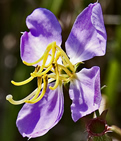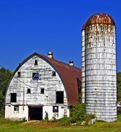
Water Oak
Quercus nigra
Five leaf buds from a sapling living in a pot.
Actual length of specimen pictured above: about 5cm.
In the nineteenth century the water oak bore the scientific name Quercus aquática. But science is seldom static. Taxonomy, in particular, often attracts the attention of generational revisionists, who create fashionable new names under the guise of objectivity. When renowned Professor Asa Gray of Harvard wrote his textbook Gray's School And Field Book Of Botany in the 1880s, the Quercus nigra referred to the "black-jack or barren oak." Today the blackjack lives under the nomenclature Quercus marilandica, while the water oak stands as the new Quercus nigra, and the aquática is merely an obscure footnote in history.
The water oak pictured above was one of White River Nursery's native Arkansas trees until I acquired it for twelve dollars a few weeks ago.
∞
Photo by Beau Bosko
Crow's Cottage • April 10, 2013
Smitten by
the Trees of Arkansas
Monday, April 15, 2013
Rural Washington County, Arkansas
The trees I plant and nurture begin as ideas on the imagined landscape. Some I envision growing in a special place on the garden grounds, rooted for a lifespan in the fertile Ozark soil. Others I see as saplings in a pot, residing in temporary quarters for a few seasons while making their way upward toward the heavenlies... and then, at just the right moment, finding a secure home in the good earth.
Eventually, most of my arboreal ideas are transformed into material expressions, making real the wish and the dream. I make my choices, find a source of supply, and write the check.
In our market-driven, advert-rich culture, choosing is the easy part, though the smart choice can sometimes be hard to come by. Writing the check isn't so difficult, either, especially after the writer has learned through hard knocks to live within means. The challenge is finding the right source.
My bare-root saplings arrive by truck from the nurseries of the Missouri Department of Conservation, the Arkansas Forestry Commission, and the Arbor Day Foundation. To find larger saplings and young trees for my imagined landscape, I look to commercial nurseries here in northwest Arkansas. One of my very favorites is the White River Nursery on Arkansas Highway 16 between the city of Fayetteville and the town of Elkins. The good folk at White River have gone native over the past several years, making their "Native Arkansas Trees and Perennials" initiative one of the most unique features in the local marketplace.
Sassafras
Sassafras albidum
A bud on the cusp of opening.
Actual size from bud tip to base of stem: 2.5cm.
Graceful of form and elegant of color, the little bud lives on a sassafras tree purchased for thirty-five dollars from White River Nursery's "Native Arkansas Trees and Perennials" inventory on March 6, 2013. An inch of rain fell the day I captured the photograph.
∞
Photo by Beau Bosko
Crow's Cottage • April 10, 2013
A Fashionable Movement
toward Sustainable Wildlife
Emma Franklin oversees the native Arkansas project, working with wholesale suppliers to find as many indigenous species as possible. "The previous owners of White River began to develop the concept of a perennial and native nursery," Emma said. "When Tray became owner, he kept the idea going. Now we're actively looking for whatever natives we can find, especially the perennials."
Tray Morrison acquired White River in the spring of 2010. He embraces the native Arkansas concept because it satisfies local demand for indigenous species. "Increasingly we have landscapers who are looking for Arkansas native plants in response to their customers' requests, so we try to fill that demand," he said.
Customer demand for native plants is fashionable nowadays, especially in prosperous communities like northwest Arkansas. You could say the demand is linked to a national movement toward the idea of "sustainable wildlife," inspired in part by Professor Douglas W. Tallamy's influential 2008 book, Bringing Nature Home: How You Can Sustain Wildlife with Native Plants. To some gardeners and insect enthusiasts, Dr. Tallamy's text is not only a practical guidebook for sensible gardening, but also a visionary manifesto about the dangers of "alien plant species" and the essential value of native species to the health and ultimate survival of indigenous ecosystems, habitats, and biodiversity.
Native as botanical concept and ecological creed can rouse downright militant attitudes among some serious gardeners and environmentalists. One well-known horticulturalist from down in the river valley told me last weekend she wishes she could take a chainsaw to every Bradford pear and Japanese honeysuckle in Arkansas. To Emma and Tray, native stands not for controversy, but for the opportunity to serve their customers. The term also provides a valuable descriptor of available plant stock.
"We don't go by a specific number of years to make that determination," Emma said about attempts to nail-down a precise definition of native. "Is it 30 to 50 years? Maybe we're looking at a hundred years for a plant to be at home in an area. It's a slippery concept. Our approach is to defer to something that would be agreeable with the Arkansas Forestry Commission, to the horticulturist and the landscape planner with the City of Fayetteville, and to our master gardeners. We always listen carefully to our master gardeners — what they want, what they've learned, what they're looking for."
Good Folk
The crew at White River Nursery
(from left) Scott Darnell, Emma Franklin, Charity Lewis, and Tray Morrison.
∞
Photo by Beau Bosko
In a greenhouse at White River • April 2, 2013
When I visited White River in early April, I was smitten by the many little trees — a thoughtfully structured, creatively mustered, and biologically robust stock of native specimens arrayed in informal groupings hither 'n thither about the nursery grounds. A hard rain rattled the translucent roof of the main greenhouse. It was a cold morning in a spring season reluctant to arrive. Emma paused from her duties to help me compile a list of the trees available for purchase. Here they are:
Native Arkansas Tree Project
 white oak
white oak
Quercus alba
|
 willow oak
willow oak
Quercus phellos
|
 cow oak
cow oak
Quercus michauxii
|
 nuttall oak
nuttall oak
Quercus nuttallii
|
 northern red oak
northern red oak
Quercus rubra
|
 pin oak
pin oak
Quercus palustris
|
 sawtooth oak
sawtooth oak
Quercus acutissima
|
 burr oak
burr oak
Quercus macrocarpa
|
 scarlet oak
scarlet oak
Quercus coccinea
|
 shumard oak
shumard oak
Quercus shumardii
|
 overcup oak
overcup oak
Quercus lyrata
|
 yellowwood
yellowwood
Cladrastis lutea
|
 American hazelnut
American hazelnut
Corylus americana |
 ginkgo
ginkgo
Ginkgo biloba
|
 black walnut
black walnut
Juglans nigra
|
 pecan
pecan
Carya illinoensis
|
 shagbark hickory
shagbark hickory
Carya ovata
|
 red mulberry
red mulberry
Morus rubra
|
 pawpaw
pawpaw
Asimina triloba
|
 sassafras
sassafras
Sassafras albidum
|
 Ohio white buckeye Ohio white buckeye
Aesculus glabra |
 red buckeye
red buckeye
Aesculus pavia
|
 serviceberry serviceberry
Amelanchier arborea |
 persimmon
persimmon
Diospyros virginiana
|
 vernal witchhazel vernal witchhazel
Hamamelis vernalis |
 eastern witchhazel
eastern witchhazel
Hamamelis virginiana
|
 white fringetree white fringetree
Chioanthus virginicus
|
 baldcypress
baldcypress
Taxodium distichum
|
 sugar maple
sugar maple
Acer saccharum
|
 red maple
red maple
Acer rubrum
|
 Washington hawthorn
Washington hawthorn
Crataegus phaenopyrum
|
 green hawthorn
green hawthorn
Crataegus viridis
|
 possumhaw possumhaw
Ilex decidua
|
 flowering dogwood
flowering dogwood
Cornus florida
|
 sourwood sourwood
Oxydendrum arboreum
|
|
Altitudes, Latitudes, Habitats
I suppose some botanists and most purists would argue about a few of the trees on the list, but why? Every one of these gentle living creatures, ginkgo included, is well established as a species here in Arkansas. None are enemy to the flora of the indigenous habitat. None threaten the health of our ecology or deny food sources to insects. Every tree on the list has been a part of the Arkansas landscape since before anyone of us was born.
"A native plant species is one that occurs naturally in a particular region, state, ecosystem, and habitat without direct or indirect human actions," states the Federal Native Plant Committee as quoted on the Audubon web. Wikipedia is not so windy, stating simply that "native plant is a term to describe plants endemic (indigenous) or naturalized to a given area in geologic time."
I respect White River's decision to promote the native idea because it's a sincere and reasoned effort to satisfy a demand without being cynically commercial. It's attuned to the times without so much as a hint of opportunism. For someone like me who loves trees, going to White River is like being the proverbial kid in the candy store with my weekly allowance burning a hole in my pocket.
"Owners of native nurseries are also finding it easier and easier to enumerate the benefits of their offerings," Professor Tallamy wrote in Bringing Nature Home. "Native plants are well adapted to their particular ecological niche and so are often far less difficult to grow than species from other altitudes, latitudes, and habitats. After all, these plants evolved here and were growing just fine long before we laid our heavy hands on the landscape."
Sustainable, Nurturing, Beautiful
Emma's enthusiasm for Arkansas native plants is rooted in her passion for flora of all varieties and her abiding interest in learning about her new home in the Ozarks. Granddaughter of Dr. Byron Leon Franklin, a well-known country doctor from southeast Missouri, Emma was raised in Popular Bluff, where the Mississippi River dominates the local ecology. She joined the crew at White River early in the spring of 2012, not long after moving to the West Fork area to pursue her dream of becoming a farmer.
"Northwest Arkansas is a very different ecosystem than the river delta where I grew up," Emma said. "I enjoy learning about this area. And I like connecting with our customers to help them create sustainable gardens with plants that are going to feed them and their families. We are helping gardeners create habitats for wildlife, and we are helping them make beautiful gardens — all with plants that use less water and not a lot of intensive care."

Golden Raintree
Koelreuteria paniculata
Young leaves emerge from a sapling in the arboretum.
The baby leaves are only three days out of the bud. Wispy and delicate, they are very small, about one-fifth the size shown here.
Botanists tell us the raintree was introduced to the USA in 1763. Is it native by now? Are 250 years time enough to make the species indigenous to North America? As I understand the argument put forth by the purists, probably not. But consider this: The word "indigenous" entered the English language only a hundred years before the first raintree from the Orient arrived by boat in the New World. Is "indigenous" native to the English language? Where do we draw our timelines on the psychic sands?
On a commonplace level, a golden raintree sounds way too exotic for the Arkansas Ozarks. My first edition (1950) of Trees of Arkansas by Dwight Munson Moore makes no mention of the species. However, my Fourth Revised Edition (1991) of the same handbook devotes a full page to the "Goldenraintree," noting that it is "widely planted as an attractive flowering tree" and is also known as the "China-tree." It may not be native in the mind of a strident purist, but somewhere along the line, the raintree became a Tree of Arkansas in the studied opinion of the natural state's foremost botanist of the twentieth century. (May God rest his soul.)
∞
Photo by Beau Bosko
Crow's Cottage • April 11, 2013


 White River Nursery on Facebook
White River Nursery on Facebook
For particulars about location, hours of operation, contact information, and special promotions, White River Nursery's facebook page tells all.
 Chicken Moon Farm
Chicken Moon Farm
It's gotta be one of the sweetest places on the planet! Founded by Charity Lewis, one of the crew at White River, Chicken Moon Farm is a permaculture adventure in connecting with nature and making a happier, healthier world. Charity's web telling about the farm is a delight — and when you go there, be sure to read the wonderful little story of how the farm got its name.
 Why Plants Change Their Names
Why Plants Change Their Names
Kew Royal Botanic Gardens in London on the River Thames asks the question, "Why, oh why, do botanists keep changing the names of our garden plants?" It's a leading question, of course. Kew's answer is based on three reasons: taxonomic, misidentification, and nomenclatural.

One-Armed Giant Walking Stick
Megaphasma denticrus
This specimen is about 14 cm long.
Did it lose its right arm in battle against a spider, maybe during an attack by a blue jay? Or was it created that way through a genetic mishap? OK, we know that walking sticks don't have arms, but anthropomorphic notions about insects can be useful vehicles for metaphor. As for simile, this critter has upper arms like ears of corn. Any way you look at it, North America's largest insect is a strange looking bug. As for that stout looking pincher on its tail, don't worry: This gentle giant eats only leaves and grass. The pincher is a male appendage dedicated to the act of reproduction.
∞
Photo by Beau Bosko
On a standing stone at Doghenge, Crow's Cottage • July 18, 2012

The leaf of a young tulip poplar
14 July 2012
Gone
Illusion
of the Temporal
Sometimes it seems forever, or on the edge of it, the duration of time assigned by perception to a particular string of moments. Then I look up, or back, and they're gone: the crimson bud of the hibiscus, withered into a ragged whorl n'er to unfurl again; the block of days and nights devoured since the last promise given; the decades of a life gone and fallen into the night. There's too much disorder in the diminishing state of energy here at the cottage. What appears to be slowing down passes much too swiftly.
A hibiscus flower in the time of its passing
Yesterday during the last hour of sunlight, I gave the tulip poplar a cool, sustained shower. The stress of the drought has turned hundreds of her leaves into crumbly, yellow-brown reminders of the dangers that sustained heat and rain-starved earth can bring to bear upon the life force of a tree. She is a tall and slender poplar, rising about sixty feet from the rocky earth, with a leafy girth measured at about 15 paces from south to north along the slope leading into the hollow. She stands not far from the front steps of Doghenge, our name for the sandstone patio out back, and provides soothing shade and dappled light under the late afternoon sun. Now is not the time to lose her graceful mien.
Bathing a mature tree is a merciful act requiring patience, strong water pressure, a jet setting on the hose nozzle, and a willingness to pay the cost of rapidly spinning dials on the water meter. I slowly encircle the tree, holding the hose high and steady, spraying the tight water jet up and down along the trunk, then over to the branches and outward to the leaves, back and forth and 'round and 'round as long as my arms and neck can sustain it. Yesterday the tightly wound stream reached about two-thirds up the trunk.
Now and then I switch the hose setting to gentle shower and bathe the lower leaves and branches with the water of life. Then I turn the nozzle to the earth, soaking the soil to give drink to the roots. After a while the scene begins to look and sound like a rain shower, the water dripping rhythmically in a lazy cascade from leaf to leaf, the green surfaces glistening from the moisture, the ground underneath forming little pools on the darkening soil. Standing there, I feel purposeful, attuned to my natural companions and their elemental needs.
I devoted about 45 minutes to my ministrations. Dark had begun to gather when I reluctantly put down the water hose and turned toward the back door of the hacienda. "Dinner," she announced, "is served." Glancing back, I pledged to remain diligent until the drought fades into autumn.
Tulip Poplar Leaves
Liriodendron tulipifera
One leaf fell to the ground, a casualty of the stressful July dryness and heat.
It lived on the mature poplar standing tall to the west of Doghenge.
The bright green specimen is the topmost leaf
on a 38-inch tall spring sapling growing in a pot in the tree clinic.
The fallen yellow leaf is about 12 cm wide.
The healthy leaf is 25 cm from tip-to-tip.
Alas, the water drops are from the hose and not from sorely needed rain.
∞
Photos by Beau Bosko at Crow's Cottage on July 17, 2012

Tropical hibiscus beginning to unfurl
an hour after sunrise on 11 July 2012
Maiden
Rose of Sharon Opens.
One of the wonders of perennials is their sense of collective timing. As soon as one of their showy number passes from the scene, another enters to keep the visual narrative moving forward. This year's tale began in February with the emergence of the crocuses [croci] and continued this morning with the opening of the maiden bloom of the new rose of sharon (Hibiscus syriacus), a sprightly bush planted in mid-March as a bare-root baby in a pot.
The bloom was expected — I've watched the several tightly wrapped buds on the plant's two thin stalks grow round and fat over the past few weeks — but in the typical fashion of newborns, the exact day of the first blossom's opening defied soothsaying. Checking yesterday just before sunset, I wondered if the time might be near.
I've heard that a rose of sharon bush can live for a quarter of a century or longer, so this morning's maiden bloom could be the first of thousands. For now, the singular first flower is sufficient unto the day.
Rose of Sharon
Hibiscus syriacus
The maiden bloom appeared 117 days after the bare-root specimen
was planted in its little black plastic pot. Diameter is about 7 cm.
The two stalks of the young bush stand about 38 inches tall.
Each stalk holds a dozen or more little buds.
∞
Photo by Beau Bosko at Crow's Cottage on July 11, 2012
A little stand of crimson-eyed rose mallows (Hibiscus moscheutos) live in a long, narrow bed on the north side of the driveway out front. Close cousin to the rose of sharon, the rose mallow bush begins to flower about the time the orange and yellow day lilies lose their blooms.

A crimson-eyed rose mallow
in the early morning light of 29 June 2012
The mallow flower is round and wide and deep with a tall, pale yellow stamen and pistil emerging from the crimson eye. Each day a few of them open to greet the morning sun. I can see them through the east-facing window of my study, fifty yards or so away, swaying in the breezes, or drooping under the hot sun when the wind is still. By mid-afternoon, each flower is curled back into its calyx, either to bloom again on the morrow, or n'er to open again. The mallow blossoms arrived almost a month ago. With good fortune and plenty of watering, the hardy perennial may provide flowers all the way through September.
Do not worry about tomorrow,
for tomorrow will worry about itself.
Each day has enough trouble of its own.
[Sufficient unto the day is the evil thereof.]
It does, trouble, but. . . . I wasn't troubled about tomorrow's potential evil when I viewed the rose of sharon's maiden flower and deemed it sufficient unto today. Instead, I was thinking about the satisfaction of all things needful, about how desires are fulfilled by the ability to draw upon a limitless storehouse of physical and spiritual plenty, always available. I was thinking about fruitful ways to overcome the sense of loss that sometimes creeps upon me like the thief that it is — overcoming it through sure belief in the limitless riches of the universe.
Desire can be understood in several ways, but here at the Cottage, desire is a petition and a wish, carefully formed and respectfully stated, then delivered on wings of imagination to the Divine Presence higher above and deeper within. It's not so difficult to do.
So, summer is fully upon us. Sadie Liz, mistress of the hacienda, found the season's first resurrection lily this evening. It rose on a tall stalk from fertile soil hidden by the cluster of vinca growing 'round the base of the great old oak in the front yard — the oak towering over browned grass, the surprise lily blooming where just a few days ago the last of the tiger lilies withered and fell to the earth. What mystery and wonder await the coming of the day.
Outside sing
the tree frog and cricket
by the thousands each aweigh,
a mighty chorus as holy and as soothing
as any sung at cathedral or at crib.
Summer's song brings melodies of life assured,
of moments unbound by the measure and metre of man.
Amphibian and insect unite,
sounding the arrival of night
--
shorn of fear,
free of trembling,
--
so long as the trees thrive,
so long as the water flows,
and soaks beneath the dry gray dust,
to moisten and feed all invisible roots.


Indian pink
Rain?
Heat Wave Breaks.
South of us, north of us, the rain fell — just a few miles away and all 'round us came momentary relief for the parched earth. To our dismay, the fifty-percent chance missed Three Dog Acres yesterday, last night, this morning. We are bone dry. The forecast — and the potential for good it portends — was tantalizing and remains so. Fifty percent again today, according to the charts on TV. We shall see.
Each day out there in the gardens offers a choice between the bemoaning of losses and the celebration of gains. I waver 'tween the two. A French marigold withers away, brown and brittle. Tiny, yellow, starlike blooms emerge on the tall stalks of the Indian pink (Spigelia marilandica). Tender leaves on the maple saplings curl and crumble. Brilliant crimson blossoms as big as saucers break forth with gusto on the tropical hibiscus (Hibiscus rosa-subebsus). An elegant white zinnia rises to majestic maturity in the evening light, but this morning, a third of it is gone, eaten away by a caterpillar or some other hungry nocturnal critter from the insect world.
The sun sets. No rain. The chances have passed for now. Water sprinklers spin and splash in the dark night.
The water authority tells us we tapped into 20,848 gallons from May 11 to June 12 at a cost of just under two hundred dollars. This afternoon when I dropped by the office to pay the bill, I asked one of the managers if our consumption seemed excessive. "Flowers and trees?" he asked. A lot of 'em, I replied. "That's about right," he said. "People don't realize trees need watering, too." A woman at a desk behind him looked up from her computer monitor and said, "One of the Baptist churches spent over two thousand dollars on water last month."
The hand of the Lord was on me,
and he brought me out by the Spirit of the Lord
and set me in the middle of a valley;
it was full of bones.
He led me back and forth among them,
and I saw a great many bones on the floor of the valley,
bones that were very dry.
He asked me,
'Son of man, can these bones live?'
Bemoaning losses, celebrating gains . . . . My desire is for each of the annuals to live until the fullness of the season passeth into frost, and for the perennials to thrive and blossom at their appointed times. When one or another doesn't — when a white impatiens unexpectedly falls to death's blow, or a tall limb of a crepe myrtle loses its sap and fails to flower — I pluck the one from the moist soil, saw the other off the hard trunk, and toss the gleanings to the margins. I do so with a strange regret, knowing that natural change should not be resisted, that death is an essential aspect of the mystery of life, a daily commonplace in the perpetual movement toward regeneration, but knowing also that a fragment of natural beauty is now lost to me, and that a living thing I nurtured and admired is no more to be seen. Sometimes I whisper in my solitude, a tragedy a tragedy, then chastize the thought. How can I equate the unwanted loss of a flower to an epic act?


 The Tropical Hibiscus: Queen of the Tropics
The Tropical Hibiscus: Queen of the Tropics
Like roses and peonies, tropical hibiscuses attract a subculture of enthusiasts. I can see why. The flowers are gorgeous, large, and plentiful. Here in the Ozarks, a tropical hibiscus cannot survive the winter outdoors. Our one specimen, taken inside just before the first frost, struggled mightily last winter, losing many if not most of its leaves. Returned to the outdoors in April, it slowly but steadily regained its hardiness. Now it thrives, finding the dry heat of July particularly nurturing. The website linked here is one of the favorites of hibiscus devotees.
 Indian Pink: Spigelia marilandica L.
Indian Pink: Spigelia marilandica L.
The delicate flowers of the Indian pink are a new addition to Crow's Cottage. We found our specimen in May, displayed in a back greenhouse of a nearby nursery, and we've nurtured it ever since. This fall it shall be freed from its little black pot to find a place in the soil of the gardens. Larry Stritch of the US Forest Service wrote about this delightful "uncommon native wildflower," featuring it as "Plant of the Week" in the "Celebrating Wildflowers" section of the US Department of Agriculture web. The yellow petals of the Indian pink pictured in the 9 July 2012 dateline of this entry are about 2 centimeters in length.
Star Jonquil
Narcissus Xintermedius
A natural hybrid begat by the union of jonquil and narcissus,
the Star Jonquil is native in the wild to southern Europe.
Growers in the Lone Star State
are known to claim it under the name Texas Star Jonquil.
You can also call it an Arkansas daffodil
because it is commonplace here.
Or, if you want, you can disagree
and conclude that the specimen pictured above
is actually
a large-cupped Red Devon narcissus (Narcissus 'Devon').
Who knows for sure
in a land of taxonomical complexity
and commercial branding?
http://zipcodezoo.com/plants/n/narcissus__devon_/
http://www.hsu.edu/interior2.aspx?id=11692
∞
Photo by Beau Bosko at Crow's Cottage on March 12, 2012
Fading Tulip
With over one hundred species
and who knows how many cultivars among its clan,
the genus Tulipa is immensely popular among fanciers of bulbs.
Beautiful and distinctive on their tall stalks,
tulips also display elegance in decline.
∞
Photo by Beau Bosko at Crow's Cottage on March 5, 2012
Nonesuch Daffodil
Narcissus x incomparabilis
The daffodil's flower is a sure sign of winter's impending end.
This specimen lived in the north driveway garden bed
among irises, lilies, peonies,
and other flora planted by the previous gardener,
bless her soul in heaven.
∞
Photo by Beau Bosko at Crow's Cottage on March 5, 2012





 white oak
white oak
 willow oak
willow oak
 cow oak
cow oak
 nuttall oak
nuttall oak
 northern red oak
northern red oak
 pin oak
pin oak
 sawtooth oak
sawtooth oak
 burr oak
burr oak
 scarlet oak
scarlet oak
 shumard oak
shumard oak
 overcup oak
overcup oak
 yellowwood
yellowwood
 American hazelnut
American hazelnut
 ginkgo
ginkgo
 black walnut
black walnut
 pecan
pecan
 shagbark hickory
shagbark hickory
 red mulberry
red mulberry
 pawpaw
pawpaw
 sassafras
sassafras
 Ohio white buckeye
Ohio white buckeye red buckeye
red buckeye serviceberry
serviceberry persimmon
persimmon
 vernal witchhazel
vernal witchhazel eastern witchhazel
eastern witchhazel
 white fringetree
white fringetree baldcypress
baldcypress
 sugar maple
sugar maple
 red maple
red maple
 Washington hawthorn
Washington hawthorn
 green hawthorn
green hawthorn
 possumhaw
possumhaw flowering dogwood
flowering dogwood
 sourwood
sourwood![]()



 White River Nursery on Facebook
White River Nursery on Facebook
 Chicken Moon Farm
Chicken Moon Farm
 Why Plants Change Their Names
Why Plants Change Their Names





































